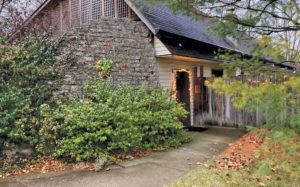
The roof, added to resolve chronic leaks, had a side benefit: people no longer walk over the house without realizing it.
Jim and Becky Cavnar built an “earth-sheltered” home on Miner St. in 1981, the same year that their friends the Walterses moved to a big Victorian house on Cherry. With the help of members of the Word of God, the charismatic Christian community to which both families belonged, the Cavnars poured a concrete slab, walls, and a ceiling—then mounded soil over three sides and the top. The windowed south side let in sunlight.
Most people build earth-sheltered homes for the thermal and noise insulation the soil provides. However, the impetus for this one was not energy reduction but to reduce allergens in the air—Becky Cavnar had many allergies.
In 1991 the Word of God fragmented. The following year the Cavnars moved to Florida, where Jim now heads the global charity Cross Catholic Outreach. The Walterses, meanwhile, were looking for a disability-friendly home.
In the mid-1980s, Dennis emails, he was diagnosed with spinal muscle atrophy. The degenerative disease progressed slowly, but late in 1991, he fell twice, breaking an ankle each time. He and Susan “agreed that our days in that house were numbered; we needed to find something safer for me, preferably all on one level.”
With four bedrooms and two-and-a-half bathrooms, the Cavnar house had room for their four kids. The living room, dining room, and bedrooms were on the sunny south side. And there were no stairs.
Since from most angles an earth-sheltered home looks like a grassy hill, it’s not uncommon for people to treat them as public parks. When the Walterses moved there, people often unknowingly walked over their home to go between Fountain and Miner streets.
As with too many mid-century homes, the flat roof leaked, and the layer of soil above it made the leaks more difficult to find. More than once, the roof had to be temporarily provided with extra support so that earth-moving equipment could drive on it to remove the soil to make repairs. These substantial efforts to create a leak-proof roof were not entirely successful, and finally a shed-style conventional roof was built above the house. This resolved the leak problem and the neighborhood cut-through behavior but eliminated the appealing “green roof.”
The Walterses are now empty-nesters. A retired educator, Susan is leveraging her master-gardener skills to turn the berm into a flourishing garden. Dennis, a retired technical writer, serves as a deacon at St. Mary’s Catholic Church in Manchester.
“Like all houses, ours has its problems and needs repair,” he writes. “But it has proved a godsend to me, and is the perfect home for someone with disabilities.”